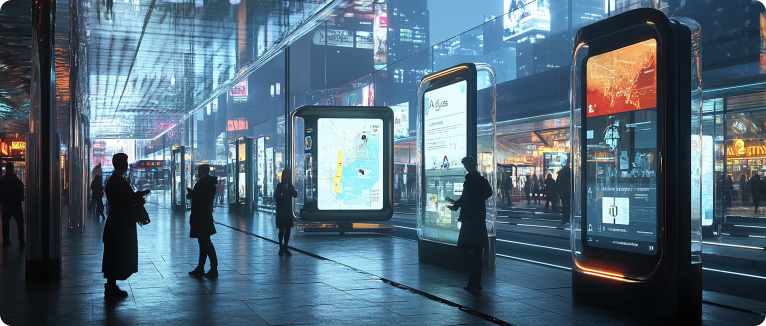In the ever-evolving world of advertising, both digital signages and static billboards play crucial roles in reaching consumers. While both are visual media, the approaches to marketing on each differ significantly due to their unique characteristics. This blog explores why brands need different strategies for digital signages and static billboards, offering insights into maximizing the impact of both platforms.
Understanding the Key Differences
To develop effective marketing strategies, it’s essential to understand the differences between digital signages and static billboards. While both aim to capture attention, their methods of doing so vary.
- Digital Signages: These are electronic displays that can show dynamic content, such as videos, animations, or rotating messages. They can be interactive, integrated with other technologies, and updated in real-time.
- Static Billboards: These are traditional printed or painted signs that remain fixed in content. While they have a longer lifespan, they lack the flexibility and dynamism of digital signages.
Strategies for Digital Signages
Marketing on digital signages requires an approach that leverages their flexibility and interactive capabilities. Here are some key strategies:
1.Dynamic and Engaging Content
Digital signages excel at capturing attention with dynamic content. Brands should create engaging visuals, animations, or short videos that tell a compelling story in a matter of seconds. Consider incorporating motion graphics or transitions to keep the content fresh and interesting.
2.Real-Time Updates
One of the advantages of digital signages is the ability to update content in real-time. Brands should use this feature to share timely information, such as promotions, events, or news. This flexibility allows marketers to adapt to changing circumstances and stay relevant.
3. Interactivity and Customer Engagement
Digital signages can be interactive, allowing customers to engage with the content. Brands should explore interactive features like touchscreens, QR codes, or augmented reality experiences. These elements not only attract attention but also create memorable interactions that can influence purchasing decisions.
4.Integration with Other Technologies
Digital signages can integrate with other technologies, such as social media, data analytics, and IoT devices. Brands should consider leveraging these integrations to create a cohesive marketing experience. For example, displaying user-generated content from social media or using IoT sensors to trigger specific messages based on customer behavior.
Strategies for Static Billboards
Static billboards offer a different set of opportunities and constraints. Brands need to focus on simplicity and longevity in their marketing strategies. Here are some key approaches:
1.Clear and Concise Messaging
Static billboards require clear and concise messaging. Since the content doesn’t change frequently, brands should focus on creating impactful messages that can be understood at a glance. Use bold text, simple graphics, and high-contrast colors to ensure visibility from a distance.
2.Long-Term Brand Awareness
Static billboards are ideal for building long-term brand awareness. Brands should consider using consistent themes, slogans, or imagery to reinforce their message over time. The static nature of these billboards allows for prolonged exposure, which can be effective for reinforcing brand identity.
3.Strategic Placement
Placement is crucial for static billboards. Brands should select locations with high visibility and foot traffic to maximize exposure. Consider targeting key locations, such as highways, urban centers, or busy intersections, where the billboard can be seen by a large audience.
4.Simplicity and Timelessness
Since static billboards remain unchanged for extended periods, brands should aim for simplicity and timelessness in their design. Avoid overly complex graphics or time-sensitive messages that might become outdated. A clean, timeless design ensures the billboard remains effective over its lifespan.
Signaxe Opinion
Marketing on digital signages and static billboards requires distinct strategies due to their unique characteristics. Digital signages offer flexibility, interactivity, and real-time updates, allowing brands to create dynamic and engaging content. On the other hand, static billboards excel at building long-term brand awareness with clear and concise messaging By understanding these differences and adopting tailored strategies, brands can make the most of both platforms, reaching their audiences effectively and leaving a lasting impression.


